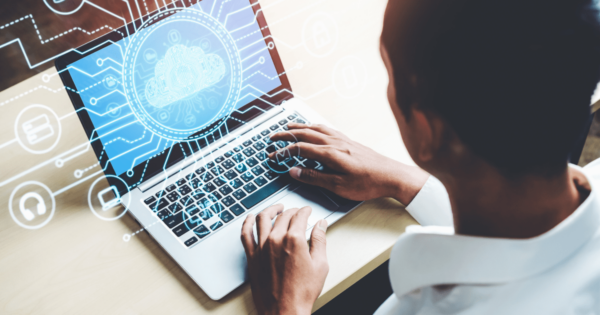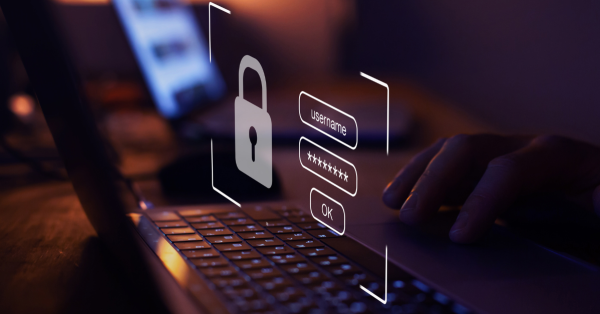Ensuring Secure Collaboration in the Digital Age
In today’s digital age, meeting rooms have undergone a significant transformation with team members adopting remote working. Flip charts and whiteboards are a thing of the past as businesses have embraced the digital revolution of the work environment and hybrid working. While this shift has impacted workplace productivity, it has also created new challenges in the realm of cybersecurity.
In this blog, we discuss the landscape of cybersecurity threats and share strategies you can use to safeguard sensitive information shared in digital meetings.
The Digital Transformation of Meeting Rooms
The growth and adoption of digital technology available has changed the way meetings are conducted. Meeting rooms are no longer just physical spaces; they have become hubs of technological adoption. Regardless of whether you use Microsoft Teams Rooms, Zoom Rooms, or another technology platform, the security challenges are similar.
Meeting rooms are now equipped with a plethora of digital tools including video conferencing and cloud-based communications platforms. These technologies have undoubtedly enhanced communication and collaboration, enabling teams to work together, regardless of their physical location.
The Cybersecurity Challenge
However, the integration of technology into meeting rooms has also exposed organisations to new risks. The very tools that enable secure collaboration can also become entry points for cyber threats.
Some of the key cybersecurity challenges faced by businesses using meeting technology:
- Data Leakage
Confidential information is often shared and discussed during meetings. If not secured, this data can be intercepted or leaked, leading to serious consequences.
- Unauthorised Access
Unsecured meeting room systems can be vulnerable to uninvited guests. Hackers can exploit gaps in security to gain control of cameras, microphones, and displays, giving access to confidential information.
- Malware and Phishing
Meeting room equipment can be compromised by malware or phishing attacks.
Malware is a broad term that encompasses various types of malicious software designed to disrupt, damage, or gain unwelcome access to computer systems, networks, and devices. Malware can take many forms, including viruses, worms, Trojans, ransomware, spyware, adware, and more.
Phishing is a cyberattack technique that relies on social engineering to deceive individuals into revealing sensitive information, such as usernames, passwords, credit card numbers, or other personal details. Phishing attacks typically occur via email, but they can also happen through text messages, social media messages, or phone calls.
- Privacy Breaches
Privacy regulations, such as GDPR, require organisations to protect the personal information of individuals. Unauthorised access to meeting room systems can lead to breaches of privacy which can be extremely damaging.
Strategies for Meeting Room Security
To address these challenges and ensure secure collaboration in the digital age, organisations need to implement a comprehensive cybersecurity strategy for meeting rooms.
Here are some essential strategies:
- Secure Networks
Ensure that meeting room equipment is connected to a secure network with robust firewalls and intrusion detection systems. Also, regularly update network devices to protect against known threats.
Choose collaboration platforms that prioritise security. Look for platforms that offer end-to-end encryption, user authentication, and data access controls.
- Encryption
Encrypting data is the process of converting information (data) into a coded or unreadable format using algorithms and encryption keys. The primary purpose of encryption is to protect data security, making it difficult for unwanted guests or entities to access, read, or decipher the information.
Encrypt all data transmitted and stored within meeting room systems. This includes video conferences, chat messages, and shared documents. Encryption ensures that if data is accessed, it’s unreadable to unauthorised parties.
- Access Control & Security
Implement strict access controls for meeting room equipment and collaboration platforms using strong authentication methods like multi-factor authentication (MFA). Only authorised users should be able to access and control these systems.
Educate employees about the importance of cybersecurity in meeting rooms. Train them to recognise phishing attempts and practise safe data-sharing habits.
Don’t overlook physical security. Ensure that meeting rooms are locked when not in use, and documents and devices are stored securely.
Technologies to Enhance Meeting Room Security
In addition to strategies, there are several technologies that can enhance meeting room security.
- Implement endpoint security solutions that can detect and prevent malware and other threats on meeting room devices.
- Choose video conferencing tools with security features including encrypted communication, secure logins, and the ability to lock meetings to prevent unwanted access.
- Many meeting room devices are part of the Internet of Things (IoT). Implement IoT security solutions to protect these devices from cyber threats.
- Utilise artificial intelligence (AI) and machine learning to monitor meeting room activities for unusual behaviour, which can indicate potential security breaches.
- Invest in secure document sharing and storage solutions with encryption and access controls to protect sensitive information shared during meetings.
The intersection of meeting rooms and cybersecurity is a critical area that organisations must address as they embrace digital transformation and provide secure collaboration. While modern meeting rooms offer tremendous benefits in terms of productivity and customer experience, they also present new cybersecurity challenges.
At Connect NZ, we’re committed to providing our network with valuable information to support you to make better decisions for the future of your business. A key area that we can help with is Cyber Security.
We’ve put together a Cyber Security Best Practice Guide that is designed to guide your business to make more informed decisions about securing your digital footprint.
Always keep in mind that to ensure secure collaboration in the digital age, organisations must adopt a proactive approach to meeting room security. This includes implementing robust cybersecurity strategies, securing network infrastructure, educating employees, and leveraging advanced technologies. Check out our Modern Workplace Technology options.
By prioritising meeting room security, businesses can continue to reap the benefits of digital transformation without compromising the confidentiality, integrity, and availability of their sensitive information. In a world where collaboration is increasingly digital, security should always be at the forefront of any organisation’s meeting room strategy.



